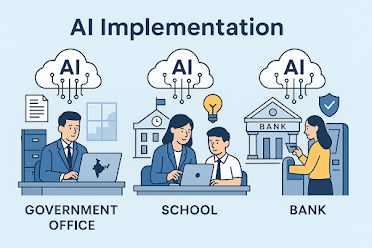Artificial Intelligence (AI) is rapidly reshaping the operational landscape of both public and private sectors across the globe. In India and beyond, government offices, educational institutions, and banks are integrating AI to enhance efficiency, transparency, and service delivery. From smart governance and personalized learning to fraud prevention and automated banking, AI is driving a digital transformation aimed at creating more intelligent, responsive, and secure systems.
1. AI in Government Offices
Governments are embracing AI to streamline bureaucratic processes, improve citizen services, and enhance policy-making.
Key Implementations:
-
Smart Governance: AI-powered chatbots and virtual assistants handle citizen queries, issue certificates, and guide users through government portals (e.g., UMANG app in India).
-
Document Automation: Natural Language Processing (NLP) is used to scan, verify, and digitize large volumes of paperwork, reducing human errors and speeding up processing times.
-
Predictive Analytics: AI helps in crime prediction, disaster management, and urban planning by analyzing large datasets and forecasting future trends.
-
Facial Recognition: Used for security and attendance systems, especially in public offices and law enforcement.
Benefits:
-
Reduced workload and human error
-
Faster service delivery
-
Improved transparency and tracking
2. AI in Schools and Education
AI is revolutionizing education by personalizing learning experiences, automating administrative tasks, and supporting teachers and students alike.
Key Implementations:
-
Personalized Learning Platforms: AI systems adapt lessons according to the student’s pace, learning style, and weaknesses. Tools like BYJU'S or Khan Academy use AI to offer custom learning paths.
-
Grading Automation: AI helps grade multiple-choice questions and even essays using NLP, saving teachers valuable time.
-
Smart Classrooms: Voice-activated assistants, real-time translation tools, and virtual teaching aids enhance the interactive learning experience.
-
Attendance & Behavior Monitoring: Facial recognition and sentiment analysis are used to track student attendance and engagement levels.
Benefits:
-
Enhanced learning outcomes
-
Efficient teaching workflows
-
Early identification of learning difficulties
3. AI in Banks and Financial Institutions
The banking sector has been one of the early adopters of AI, focusing on security, customer service, and operational efficiency.
Key Implementations:
-
Chatbots and Virtual Assistants: Banks use AI-based bots (like HDFC’s EVA or SBI’s SIA) to handle customer inquiries, reducing call center loads.
-
Fraud Detection: AI systems monitor transactions in real-time, flagging anomalies and preventing unauthorized access.
-
Credit Scoring & Loan Disbursement: Machine learning algorithms assess credit risk more accurately by analyzing non-traditional data (e.g., mobile usage, spending patterns).
-
Robo-Advisors: These AI tools provide investment advice and portfolio management for retail customers.
Benefits:
-
24/7 customer support
-
Enhanced security and fraud prevention
-
Quicker, data-driven financial decisions
Challenges of AI Implementation
Despite the promise, AI adoption faces several hurdles:
-
Data Privacy Concerns: Sensitive personal and financial data need strong protection.
-
Skill Gaps: Government and educational institutions often lack trained personnel to manage AI tools.
-
Infrastructure Issues: Especially in rural areas, lack of digital infrastructure hinders AI deployment.
-
Ethical and Bias Issues: AI systems may reflect the biases of their developers or data sets.
Conclusion
Artificial Intelligence is no longer a futuristic concept—it is a practical tool that is already reshaping how governments, schools, and banks operate. While challenges remain, the potential for AI to increase efficiency, improve services, and make institutions smarter and more responsive is undeniable. As policies and infrastructure continue to evolve, AI implementation will become an even more integral part of modern







No comments:
Post a Comment
Please don't do panic comments